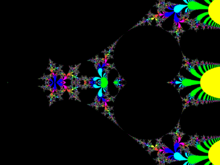The following fractal is a Mandelbrot set with the quadratic equation replaced by powers, also known as a tetration escape fractal.

I generated this fractal thirty years ago. By extending tetration to the complex numbers I hope to plot the tetrational map also referred to as the pentation escape fractal.
Computing the Mandelbrot set is greatly accelerated by compiling using FunctionCompile. Unfortunately using pixel0^pixel instead of pixel^2+pixel0 in the quadratic equation breaks the compilation. I'm afraid that without a useful FunctionCompile statement I will not come close to the speed needed to plot a pentation fractal.
basicFun = Function[{Typed[pixel0, "ComplexReal64"]},
Module[{iters = 1, maxIters = 10000, pixel = pixel0},
While[iters < maxIters && Abs[pixel] < 10000,
pixel = pixel0^pixel;
iters++];
iters]
];
compiledFun = FunctionCompile[basicFun]
ArrayPlot[
Table[compiledFun[x + I y], {y, -2.5, 2.5, .0025}, {x, -3.,
3., .0025}]]
What is the recommended method of compiling pixel0^pixel where both are complex values?